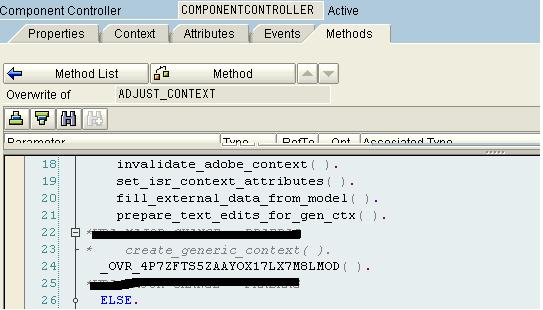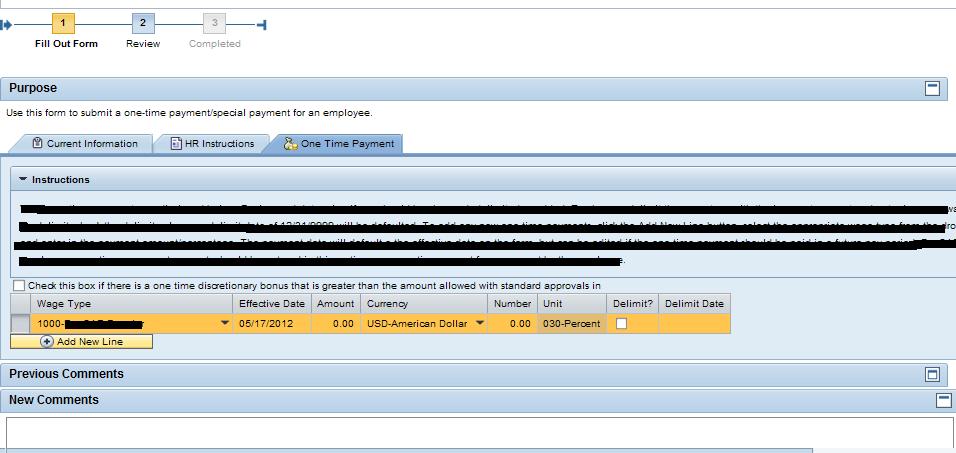
- SAP Community
- Products and Technology
- Enterprise Resource Planning
- ERP Blogs by Members
- HCM Processes & Forms - Moving from Adobe to WD AB...
- Subscribe to RSS Feed
- Mark as New
- Mark as Read
- Bookmark
- Subscribe
- Printer Friendly Page
- Report Inappropriate Content
In my last blog I had elaborated on creating the component interface and the WDA form component, in this blog I will cover the integration of standalone web dynpro application with the ISR framework.
My first priority was to disable the Adobe view and plant my WDA application in that place, so I identified the view in the QISR_UI component where the Adobe form gets embeded, and then I enhanced the view by adding a view contiainer element in that, this view container is the one which will hold my web dynpro application.
But before anything else, I needed to check the switch in the z-table I have created and store the value in an attribute.
I created a post exit method for the SET_EXTERNAL_DATA of component controller and set the switch attribute based on it.

The view contianer created in the view VIEWSHOWFORM.

Next, I created a component usage of component interface in the properties and then did override of the view method INIT and inserted the code for dynamic component use.

And then, overided the WDMODIFYVIEW method and inserted the following code to remove the UI node of adobe form with the reference of the UI root container. So now that the Adobe form is removed, my WD component can sit comfortably in that space.
The method CREATE_GENERIC_CONTEXT of the component controller is the one where data from ISR is fetched for creating the context of the main webdynpro compnent, so I override this method too, and called the set_data method of my web dynpro component interface to push data to the WDA app.

Note that the long text data for the comments needs to be set separately.
The override method of create_generic_context was not getting called in the ADJUST_CONTEXT method for reason unknown, so I just overrode the ADJUST_CONTEXT method and called the override method of CREATE_GENERIC_CONTEXT.

Once the set_data calls are done at the appropriate points, the web dynpro application will be able to display all the data from the ISR on the screen, we already had a generic service in place which populates ISR data before our WD method calls to set data.
In the screen shots below you can see all the fields populated on lauch of the screen.


After the user enters the data, the data needs to be sent back to the ISR framework from the context of the web dynpro. This can be done by overriding the method
FILL_INPUT_P_FROM_GENERIC_CTX, For tables, we need to fetch all the elements and then populate the lt_elements, if we dont do that then only the first line of the table gets populated in the ISR.
Screen shot of code changes for setting data.

For the current comments to be passed to ISR I needed to override the method SET_TEXT_EDITS_TO_INPUT_P, and that should be it and I was good to go with the new screens.
The performance is miles ahead of Adobe and the form is quicker to complete.
For the showing up the forms in Adobe we had built a custom program in ABAP which shows all pending and executed forms, the user can fire a printout if required.

So next time you are implementing HCM Processes and Forms with performance in mind take a relook, it is possible through Web Dynpro ABAP.
I hope this blog series is helpful to many who work in this area and thanks for reading.
Explore, Learn, and Share - Let that be our SAP Mantra.
Raghavendra Prabhu
- SAP Managed Tags:
- HCM (Human Capital Management)
You must be a registered user to add a comment. If you've already registered, sign in. Otherwise, register and sign in.
-
"mm02"
1 -
A_PurchaseOrderItem additional fields
1 -
ABAP
1 -
ABAP Extensibility
1 -
ACCOSTRATE
1 -
ACDOCP
1 -
Adding your country in SPRO - Project Administration
1 -
Advance Return Management
1 -
AI and RPA in SAP Upgrades
1 -
Approval Workflows
1 -
ARM
1 -
ASN
1 -
Asset Management
1 -
Associations in CDS Views
1 -
auditlog
1 -
Authorization
1 -
Availability date
1 -
Azure Center for SAP Solutions
1 -
AzureSentinel
2 -
Bank
1 -
BAPI_SALESORDER_CREATEFROMDAT2
1 -
BRF+
1 -
BRFPLUS
1 -
Bundled Cloud Services
1 -
business participation
1 -
Business Processes
1 -
CAPM
1 -
Carbon
1 -
Cental Finance
1 -
CFIN
1 -
CFIN Document Splitting
1 -
Cloud ALM
1 -
Cloud Integration
1 -
condition contract management
1 -
Connection - The default connection string cannot be used.
1 -
Custom Table Creation
1 -
Customer Screen in Production Order
1 -
Data Quality Management
1 -
Date required
1 -
Decisions
1 -
desafios4hana
1 -
Developing with SAP Integration Suite
1 -
Direct Outbound Delivery
1 -
DMOVE2S4
1 -
EAM
1 -
EDI
2 -
EDI 850
1 -
EDI 856
1 -
edocument
1 -
EHS Product Structure
1 -
Emergency Access Management
1 -
Energy
1 -
EPC
1 -
Financial Operations
1 -
Find
1 -
FINSSKF
1 -
Fiori
1 -
Flexible Workflow
1 -
Gas
1 -
Gen AI enabled SAP Upgrades
1 -
General
1 -
generate_xlsx_file
1 -
Getting Started
1 -
HomogeneousDMO
1 -
IDOC
2 -
Integration
1 -
Learning Content
2 -
LogicApps
2 -
low touchproject
1 -
Maintenance
1 -
management
1 -
Material creation
1 -
Material Management
1 -
MD04
1 -
MD61
1 -
methodology
1 -
Microsoft
2 -
MicrosoftSentinel
2 -
Migration
1 -
MRP
1 -
MS Teams
2 -
MT940
1 -
Newcomer
1 -
Notifications
1 -
Oil
1 -
open connectors
1 -
Order Change Log
1 -
ORDERS
2 -
OSS Note 390635
1 -
outbound delivery
1 -
outsourcing
1 -
PCE
1 -
Permit to Work
1 -
PIR Consumption Mode
1 -
PIR's
1 -
PIRs
1 -
PIRs Consumption
1 -
PIRs Reduction
1 -
Plan Independent Requirement
1 -
Premium Plus
1 -
pricing
1 -
Primavera P6
1 -
Process Excellence
1 -
Process Management
1 -
Process Order Change Log
1 -
Process purchase requisitions
1 -
Product Information
1 -
Production Order Change Log
1 -
Purchase requisition
1 -
Purchasing Lead Time
1 -
Redwood for SAP Job execution Setup
1 -
RISE with SAP
1 -
RisewithSAP
1 -
Rizing
1 -
S4 Cost Center Planning
1 -
S4 HANA
1 -
S4HANA
3 -
Sales and Distribution
1 -
Sales Commission
1 -
sales order
1 -
SAP
2 -
SAP Best Practices
1 -
SAP Build
1 -
SAP Build apps
1 -
SAP Cloud ALM
1 -
SAP Data Quality Management
1 -
SAP Maintenance resource scheduling
2 -
SAP Note 390635
1 -
SAP S4HANA
2 -
SAP S4HANA Cloud private edition
1 -
SAP Upgrade Automation
1 -
SAP WCM
1 -
SAP Work Clearance Management
1 -
Schedule Agreement
1 -
SDM
1 -
security
2 -
Settlement Management
1 -
soar
2 -
SSIS
1 -
SU01
1 -
SUM2.0SP17
1 -
SUMDMO
1 -
Teams
2 -
User Administration
1 -
User Participation
1 -
Utilities
1 -
va01
1 -
vendor
1 -
vl01n
1 -
vl02n
1 -
WCM
1 -
X12 850
1 -
xlsx_file_abap
1 -
YTD|MTD|QTD in CDs views using Date Function
1
- « Previous
- Next »
- What You Need to Know: Security and Compliance when Moving to a Cloud ERP Solution in Enterprise Resource Planning Blogs by SAP
- Five Key assessments for a Smooth ECC to S/4HANA Transformation in Enterprise Resource Planning Q&A
- An introduction into Service Management in S/4HANA Cloud Private Edition in Enterprise Resource Planning Blogs by SAP
- SAP S/4HANA Cloud Extensions with SAP Build Best Practices: An Expert Roundtable in Enterprise Resource Planning Blogs by SAP
- Minimize the disruption of your S/4HANA migration in Enterprise Resource Planning Blogs by Members
| User | Count |
|---|---|
| 2 | |
| 2 | |
| 2 | |
| 2 | |
| 2 | |
| 2 | |
| 1 | |
| 1 | |
| 1 | |
| 1 |